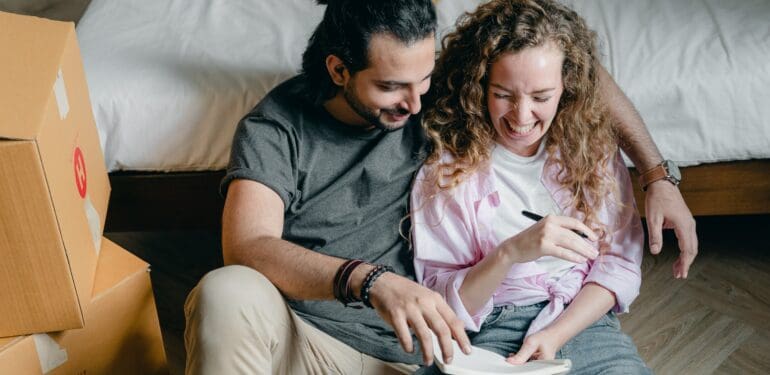Often, people dread moving because they’re relocating to a place they don’t want to be. It isn’t their first choice, and they don’t see the good in moving to the place they’re supposed to be going.
The move itself is already stressful enough. Add a deep dislike for where you’re moving to, and your stress levels get even higher. It’s hard to be emotionally secure and excited about your move when you feel like this, making mindfulness nearly impossible to achieve.
Guest post by Katie Brenneman.
Make sure you’re moving to the right place before you commit. These considerations will help ensure your move is the best decision for you:
- Does your new home accommodate your needs and future goals?
- What employment opportunities are available to you?
- Is your neighbourhood safe and close to things like parks and schools?
- Can you easily access medical care and mental health services?
- Will where you’re moving improve your quality of life? How?
The key is not to rush moving. Make sure it’s the right time and place before making a final decision.
Create an Easy Decluttering Process
One of the first things you want to do when you decide to move is to declutter your current space.
Even if you’re moving to a bigger space, you shouldn’t strive to take everything with you. This is the perfect time to get rid of old things with negative energy attached to them and make space for all the new, positive things you’ll collect in your new home.
Ensuring you have healthy relationships with the belongings you’re keeping and designing a decluttering process that helps you healthily part with items is especially important. Reviewing the size and space of your new home will help you narrow down your belongings to only those you absolutely need and that contribute to a positive mind and emotional state. Enlisting the help of friends and seeing if family members would like any of your unwanted items is also a good strategy.
The more efficient you are at decluttering, the easier it is to avoid stress and save time and money in the moving process. Implement the following tips to create a straightforward decluttering method.
Make a Checklist
You must keep your decluttering process organized for a couple of reasons to ensure everything that needs to get decluttered does, and to make the process less overwhelming.
It’s easy to miscalculate how long it will take to get everything decluttered. A checklist will help you map out all that needs to get done, and you can attach a realistic timeline to it.
Cover the following on your checklist:
- Which rooms do you need to declutter, and how you will declutter them;
- How much there is to declutter on a scale from one to ten;
- How long do you think it will take to declutter each room;
- When you want to be finished with the decluttering process.
Organize your decluttering process so that it gets done efficiently and completely.
Do One Room at a Time
Decluttering is one of those times in the moving process when you can dig into practicing mindfulness. You can be intensely focused on how you’re feeling about getting rid of the old and making space for the new. That is if you don’t rush through decluttering.
Take it one room at a time so that you can not only process your feelings but also make thoughtful decisions about what to take with you and what to leave behind. Give every room at least a day for decluttering. Larger rooms and living spaces may require a few days.
Your goal should be to finish decluttering your home at least a month before your move. That way, you have time to pack and finalize the rest of your moving details without the stress of doing it last minute.
Categorize Items By What You Are Doing With Them
Your decluttering process will be much more seamless when you have a plan for categorizing items. You want to dispose of everything in the most appropriate manner to feel good about moving on without certain things.
The simplest way to categorize items is with bins. Designate a bin for recycling, throwing away, donating, and keeping. You may need a few bins for each category. Nonetheless, put every item you pick up in the room into one of these bins so that you know exactly what you’re doing with everything once you’re finished.
Make Moving Day as Easy as Possible
You’ve finally made it to moving day. Whether it’s the most stressful day or the most invigorating, is totally up to you. You can go into it unprepared and unleash anxiety and worry. Or, you can make moving as easy as possible so that the day is mentally and emotionally stimulating rather than draining.
For the latter, start with a night-before check. Who’s confirmed they’ll help? Is everything packed and ready to go into the truck? If not, what will you complete tomorrow morning? Do you have your keys and steps for the move-in process? Will your utilities be on at the new place? Are you prepared to lock up here once everything is moved?
Then, get up early on moving day and complete any lingering tasks. You want to ensure that you give yourself ample time to get the move done, just in case there are any delays. Get in touch with your moving company or the people that are supposed to help to confirm when they’ll be there.
Make sure there is a clear pathway to move everything out of your home. Encourage everyone to take breaks when they need them as you load the truck. Make time for lunch as well if it’s going to be a long process.
Do a final walkthrough once your moving truck and car are loaded up, say your goodbyes, and get on the road to your new home. Use your travelling time to do some deep self-reflection on how far you’ve come.
Set Up Your New Space to Support Your Mental Health and Mindfulness Goals
The moving process doesn’t end once you arrive at your new home. The last stage is setting up your new space. To make this step mindful, you need to set up your new home so that it supports your mental health and mindfulness goals.
For example, plants can boost your indoor air quality. Lemon button ferns, aloe vera, peace lilies, and gerbera daisies can remove harmful toxins in indoor air. They’re also gorgeous to look at, can boost your mood, and be therapeutic to take care of.
Incorporate indoor plants in your new space and use some of these other interior design techniques that promote positive mental health:
- Decorate with colours that make you feel good, like blue for calmness and brown for warmth;
- Ensure there’s lots of natural light to boost your mood and nourish your body with Vitamin D;
- Keep everything organized with clever hacks, like using a shoe organizer in the pantry.
Set your space up with mindfulness at the forefront to ensure it’s a priority long after you’ve moved in.
Although most people count on a stressful move that’s mentally and physically draining, you don’t have to. Turn your moving process into a mindful experience that prepares you for all the positive things to come with your new home.


